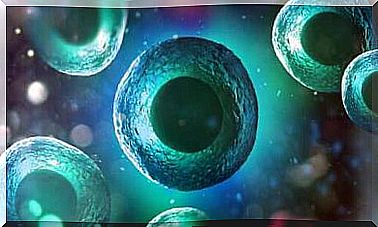Somatomorphic Disorders: Symptoms And Treatment

Somatomorphic disorders highlight the difficulty in separating the effects that body and mind have on a person’s health. The powerful interconnection that these two dimensions maintain considerably complicates the diagnosis and treatment of this type of disorder.
Before continuing, they should be distinguished from psychosomatic disorders. Even if the trigger is, in both cases, the psychological element, and there are physical symptoms, at the level of psychosomatic disorders, there is damage in the corresponding physiological system while at the level of somatomorphic disorders , there is no demonstrable organic pathology. Therefore, we speak of somatomorphic disorders when we find physical symptoms but not organic symptoms or demonstrable physiological mechanisms. In addition, there is evidence of psychological conflicts related to this symptomatology.
People with this type of disorder make their symptoms the epicenter of their lives. The discomfort they feel even comes to absorb them completely. However, very often their concern is disproportionate to the symptoms they present.
Inordinate exaggeration
As we have seen, patients who suffer from somatomorphic disorders exhibit physical symptoms with a psychological origin. These ailments are accompanied by high levels of anxiety, concern and difficulties in their daily life. Their clinical framework could be summed up with these different key points:
- Excessive concern about their symptoms and / or disruption of their normal life.
- Recurrent, constant and obsessive thoughts about the possible severity of their symptoms.
- Extreme anxiety for their health and for the catastrophic consequences to which the symptoms from which they are suffering can lead.
- Investing an inordinate amount of time and energy in their health problems.

The creation of a dependency
The chronicity of physical symptoms and the belief that these will have catastrophic consequences causes patients to develop dependency on others. These patients generate, in their entourage, the need to be treated and constantly taken care of. So, on the one hand, they neglect their responsibilities and, on the other hand, they demand constant dedication, help and support which is stifling for those around them.
Also, they have a habit of getting angry if they think they aren’t being given enough time or the attention they deserve. They believe their needs are underestimated. It is possible to see them threatening their loved ones and, in some more complex cases, they can end up committing suicide. As we see, somatomorphic disorders are really serious if not caught in time.
These disorders are difficult to detect
How to detect a disorder for which there are physical symptoms but no organic lesion? In other words, on what diagnosis can this set of ailments of which the patient complains but whose cause is not found in a conclusive physical disorder lead? The answers to these questions are found in the psychological component of these disorders. For this, to diagnose it, “there must be no somatic base that justifies the symptoms” (DSM-IV).
Even so, it would be inappropriate for physicians to diagnose this clinical setting as a mental disorder when they do not find a physical cause for the symptoms the patient displays. Beforehand, they must ensure that the tests they have carried out were as adequate as possible and that the results of the latter are correct.
It is also likely that some people overreact to their symptoms because their pain threshold is lower than what is usually in place. But that is not why we can say that they suffer from a mental illness.
This type of disorder should be diagnosed once other physical or organic disorders have been ruled out as the possible cause. And only if the patient’s response to symptoms is unusually intense.

Types of somatomorphic disorders
To categorize a disorder as somatomorphic, one must be guided by the person’s response to their symptoms or health problems. That is to say, their preoccupation, their anxiety and the degree of interference that their discomfort has in their daily tasks and obligations. Therefore, depending on these reactions, the following specific disorders can be distinguished (DSM-IV and CIE-10):
- Somatization: it is usually detected after years of existence. Symptoms can appear in any part of the body but the most common are gastrointestinal disorders (pain, meteorism, vomiting, nausea, etc.) and skin disorders (itching, tingling, bruising, redness, etc.). Sometimes there are also signs of depression and anxiety.
- Undifferentiated somatomorph: it is characterized by the appearance of multiple physical complaints, variable and persistent but not explained. In other words, the symptoms are insufficient to diagnose a somatization disorder.
- Hypochondriac: This is probably the best known in the types of somatomorphic disorders. The main symptoms are worry and fear of developing or having one or more serious and progressive illnesses. Often the patient categorizes normal or frequent sensations as exceptional and bothersome phenomena.
- Somatomorphic vegetative dysfunction: Symptoms manifest in organs innervated by the vegetative nervous system (cardiovascular, gastrointestinal or respiratory, among others). A combination of objective signs of hyperactivity (palpitations, sweating, tremors and reddening) and others that are individual, subjective and non-specific.
- Persistent somatomorphic pain: it is characterized by severe pain, which occurs mostly in circumstances of conflict or problems.
- Other: changes in sensitivity that are not due to somatic disturbances and related to stressful problems or events. For example, the hysterical globe or the grinding of the teeth, among others.
Behavioral and cognitive treatment
Although there are studies on the pharmacological treatment of pain, there is not a large enough scientific basis to make reliable treatment recommendations. Despite everything, it is recommended that the patient undergoes psychotherapy and, more specifically, behavioral and cognitive psychotherapy. This can help reduce worry and anxiety about his symptoms.
An approach that combines cognitive behavioral therapy with interpersonal therapy is also effective. This takes into account the two main characteristics of patients with somatic tendencies: the disadjusted way of perceiving and evaluating how one feels and the inadequate way of expressing one’s discomfort to others.
This type of disease is very prevalent in our society. While you shouldn’t start obsessing over it, in some cases the physical symptoms can be the result of mental distress. This, as we said at the beginning of the article, is the result of the interrelationship that exists between body and mind. But where is the line between physical and mental symptoms?










